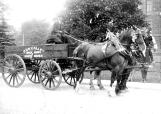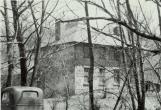1
During the course of the nineteenth century, the Helliwells, Eastwoods, Skinners, Taylors and Davies were responsible for the construction of numerous dwellings and industrial buildings throughout the area known as Todmorden. While some of these structures have been destroyed by fire or urban development, a surprising number still exist. Many have been adapted for new uses, far removed from their original functions.3
Helliwell HouseHelliwell House was constructed in 1837-38 by William Helliwell to accommodate his growing family. The structure reflected his standing in the community and was built near the banks of the Don River.
The House survives as a rare example of adobe brick construction. The technique was widely used in Europe; although it is associated now with the American Southwest and Mexico. Clay bricks are made of a mixture of straw and clay poured into a mould, and then sun-dried and seasoned. Their size can vary, but generally the bricks are much larger than oven-baked bricks.
5
The board and batten rear portion of the house was built at a separate time, possibly to provide housing for household servants.Shortly after the 1847 fire that destroyed the brewery, distillery, gristmill and his brother Joseph's house, William and his family moved to Highland Creek. In later years, William was appointed the Commissioner of Fisheries for York County.
By 1855, the House had been sold to the Taylor family and it is likely that they rented it to some of their senior staff in the paper mills. In 1901, most of the Taylor holdings, including Helliwell House, were acquired by Robert Davies.
7
Like the Taylors, Davies provided rental housing for his workers. In 1900, W.J. Routliffe Sr. and his young family moved into the Helliwell House. At the time, Routliffe Sr. was an employee of theDon Valley Brick Works. The House had been subdivided into two separate residences. The Routliffes lived in the adobe brick portion of the house until 1904. Routliffe Jr. vividly recalled that each of the four large rooms had its own fireplace.
The Radfords moved into Helliwell House during World War I. They resided in the board and batten portion of the house while the Bellamy family occupied the adobe brick portion. Rob Radford was the stable boss for the Brick Works and it was his job to look after the horses and mules that delivered the bricks to the city.
9
The Bellamy family lived in the Helliwell House from 1906 up to the late 1930s. George Bellamy was initially employed as a teamster with the Paper Mill, but by 1919 had become the stable foreman for the Don Valley Brick Works.The last known residents of Helliwell House were the Elliotts who purchased it in 1951. Marjorie Elliott was a ceramics instructor at Central Technical School in Toronto. She converted the adobe brick home into a studio-home.
A frequent visitor to the Elliott home recalled that the tea and coffee brewed with the water drawn from their cellar well always tasted salty; perhaps from the salt run-off from the road behind their home.
11
By then, nearby Fantasy Farm had become a popular location for weddings. A local resident recalled that Mr. Elliott would call out "You'll regret it!" to the wedding cars driving by his home.Helliwell House was expropriated in 1965 to become part of the Todmorden Mills Museum.
13
The Lower MillToday, only a portion of the Lower Paper Mill exists and forms part of the Todmorden Mills Museum. Although it has been commonly accepted that the Lower Mill was destroyed by fire in 1900 or 1901, neither archaeological evidence nor contemporary newspaper accounts support this claim.
It is most likely that the Lower Mill was converted to stables and storage for the nearby Brick Works when Robert Davies took over the operation. Until the construction of the Bayview Extension and the Don Valley Parkway, a brick road linked the two sites. In the late 1920s, the Brick Works used poorly fired bricks to elevate the eastern portion of the Todmorden site, to minimize damage from flooding. As a result, the ground floor of the Mill was filled in and an entrance was created in what had been the second level.






